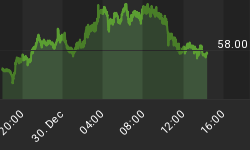Excerpted from Elliott Wave International's market analysis.
On December 23, the U.S. Federal Reserve celebrated its 100th birthday. When legislation creating its existence was signed on December 23, 1913 (in a sneaky move during a holiday week), Congress granted the Fed a monopoly on creating dollars backed by debt.
The ongoing QE program is an unprecedented use of that power. This chart of the Fed's stated capital of $55 billion compared to its total assets of $4 trillion shows the extent to which the Fed is the focal point of dollar creation and therefore credit creation.

As John Hussman at HussmanFunds.com points out, this ratio puts the Fed's leverage at a mind-boggling 73-to-1, making the average hedge fund manager (at 2.48-to-1, according to BofA Merrill Lynch's November survey) look like a conservatively invested widow by comparison.
Only the end of a century-long rise in social mood can explain how exposed to decline the Fed will be in the next phase of the credit crisis. Instead of the stabilizing hand envisioned by its founders, the Fed, by its own machinations, will be the center of instability in an accelerating debt-default spiral. Don't forget that leverage works both ways, so even a modest further rise in interest rates will sharply deflate the value of the Fed's asset stockpile.
Despite the Fed's stated goal in December 2012 to keep long-term rates low via quantitative easing, the yield on 10-year U.S. Treasury notes jumped by more than 70% in 2013. Thus, the Fed faces the possibility of massive losses in the value of its portfolio. The ultimate financial irony is that the lender of last resort has become the borrower of last resort.
In other countries, different entities have emerged to serve the same purpose. In China, domestic credit since 2008 is up 2.5 times, from $9 trillion to $23 trillion now. In a New York Times op-ed column, "Stumbling Toward the Next Crash," Gordon Brown, the United Kingdom's former prime minister, points out that this amount is more than the entire commercial banking sector of the U.S.
"China's growth of credit is now faster than Japan's before 1990 and America's before 2008, with half that growth in the shadow-banking sector." What's the shadow-banking sector? Basically, it's loan sharking. "I am a loan shark but a legal one," explains one "shadow banker" who charges rates of up to 50% a year to "debt-hungry businesses and households" whose borrowing otherwise has been reined in by new government restrictions. With past-due loans at 9.1% and the real estate market cooling, the banker reports that he "is expanding his microfinance business" with loans for weddings, car purchases, small businesses and down payments on apartments.
The base of the debt pyramid continues to expand, but its stagnant core and the impossible demands it is placing on increasingly implausible borrowers reveal that it cannot do so for long.

15 Hand-Picked Charts to Help You See What's Coming in the Markets
Prepare for 2014 with a complimentary issue of Bob Prechter's Elliott Wave Theorist
Have you ever seen price charts that tell a story clearly? Bob Prechter chose 15 charts to explain to his subscribers where the financial markets are headed in 2014. They cover markets like the S&P 500, NASDAQ, the Dow, commodities, gold, and mutual funds. With this information, they are now prepared to be on the right side of the financial markets. You can be, too, because, in a rare opportunity, we can offer you a look at the whole issue -- FREE.
Prechter says that "charts tell the truth." Here is your chance to see what truths these charts are telling. If a picture is worth a thousand words, then this latest publication is like reading more than 15,000 words of his market analysis.
Get your FREE 10 page issue of Bob Prechter's Theorist now >>
This article was syndicated by Elliott Wave International and was originally published under the headline Happy 100th Birthday, Fed. EWI is the world's largest market forecasting firm. Its staff of full-time analysts led by Chartered Market Technician Robert Prechter provides 24-hour-a-day market analysis to institutional and private investors around the world.
















